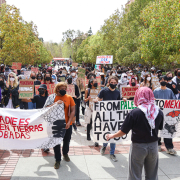New research by Professor Jazlyn Mooney brings stunning clarity to histories previously erased by hate.
“The influence of ancestry is important in helping forward any individual or race … The fact that the individual has behind and surrounding him proud family history and connection serves as a stimulus to help him to overcome obstacles when striving for success,” wrote Booker T. Washington in his 1901 autobiography, “Up from Slavery.” The notable African American author and educator highlighted the luxury of knowing where you come from — a luxury taken away from Washington and the African American community.
Referred to by some genealogists as the genealogy “brick wall,” African Americans continue to find difficulty in discovering their family history before 1870 — a year that marks five years past the official abolishment of slavery and the first year that the United States census recorded African Americans by name. Attempt to dig deeper, and an individual can find themselves going down a maze of sparse and uninformative court records and official documents that can oftentimes only provide them with a sliver of information before hitting yet another brick wall.
In her study — published in July 2023 by GENETICS — Jazlyn Mooney, WiSE Gabilan assistant professor of quantitative and computational biology, attempted to crack through this brick wall by providing information that illustrates a clearer picture of the ancestral tree of African Americans whose ancestors were subjected to slavery.
Mooney sought to answer one question:
“Given we have a dearth of genealogical records and census records for African American individuals, is it possible to give numbers for how many African and European ancestors you might have?”
The study was unique in that it relied purely on computational data, using a chart that accumulated a series of biomedical studies conducted on African American individuals.
“We may not have been able to put names to the individual, but we can tell how many of them there are,” Mooney said.
While websites like 23andMe and Ancestry use DNA swabs to uncover the genetic ancestry of an individual, Mooney addressed the study’s difference: finding a person’s genealogical ancestry. As someone goes further back in their family history, the chances that they’ll share a portion of their DNA with an ancestor decreases, as DNA gets broken down with every new familial pairing. Once someone goes seven or eight generations back into their ancestral lineage, an ancestor may be a part of your genealogical ancestry, but might not share any of the same DNA.
While genetic ancestry is limited by the amount of space on our chromosomes, genealogical ancestry accounts for the ancestors that might get lost because of this limited amount of space, providing numerical estimates of the number of people in one’s bloodline.
The computational information was then separated into three distinct time periods that begin with the origin of the African American population:
The first time period, 1619 to 1808, is marked by both Africans and Europeans contributing to the budding African American population.
The second period, 1808 to 1865, sees a decline in African ancestors because of the end of legal importation of enslaved African captives into the United States.
The third period, 1865 to 1965, begins with the abolishment of slavery and is characterized with a decline in European ancestry and decreased African immigration that resulted in a continued low African source.
The study concluded that an African American born between 1960 and 1965 has, on average, 314 African ancestors and 51 European ancestors. For Noah Rosenberg, senior author of the study and a biology professor at Stanford University, the most surprising finding was that the average African American born in that period most likely has more African ancestors present in the early 1700s rather than in the late 1700s, the peak of the transatlantic slave trade.
“It’s very likely that an African American’s ancestors trace back through the 1800s and had many ancestors who were transported in the late 1700s,” Rosenberg said. “However, that person likely also has many ancestors who were already present in the colonies or the early United States [who] trace a few generations back early in the 1700s.”
Mooney’s interest in genealogy sparked through the curiosity she held about her own family history. Growing up in New Mexico, her maternal grandmother resided on a reservation as a member of The Navajo Nation, while her maternal grandfather’s genealogical history traced back to Jewish ancestors who were exiled from medieval Spain and migrated to New Mexico in the 1600s, according to USC Today.
While her maternal ancestral lineage can be traced all the way back to the 1500s, Mooney knows very little about the roots of her African American father.
“As far as my dad, he has some relatives who are from Jamaica, and then the people who are from here basically lived somewhere along the Texas-Oklahoma border,” Mooney said, “And that’s like all we know — we were there and that’s it.”
“As someone who’s the host of a [genealogy] TV show, we make it look easy,” said Kenyatta D. Berry, longtime genealogist and host of PBS’ “Genealogy Roadshow.” In the show, Berry, with the help of other genealogists and historians, travels across the U.S. to help individuals uncover the truth about their family history — one that is often linked to a historical figure or event. “All you see when watching the show is [me] showing the documents. You don’t see me at the microfilm reader or doing that other stuff. You just see me flashing documents and telling their stories.”
Not conveyed in the 10 to 20-minute segments of the show is the tireless work Berry and her colleagues do to break down the 1870 “brick wall” and unveil as much about an individual’s history as possible. They’ve found success using the Freedmen’s Bureau records — a collection of handwritten records ranging from letters, marriage and hospital records, and census lists to details of food rations. While these records were once only available in Washington D.C., they have now been digitized and placed in the Freedmen’s Bureau Search Portal, making it much more accessible to the public.
There are also Freedman’s Bank records. Described by Berry as a “mini genealogy snapshot,” these records hold the signatures of individuals, most of whom served in the U.S. Colored Troops and opened bank accounts. The depositors would often include the names of relatives in their documents, making it a beneficial tool for uncovering one’s ancestry.
However, labor contracts — contracts exchanged between the enslaved or formerly enslaved and their slave owners — have been a major guiding force in Berry’s work. A labor contract is what ultimately helped her in her own genealogy journey, aiding her in the discovery of her fourth great-grandfather, Lewis Carter.
“I was able to see [that] Dr. John W. Taylor employed Lewis Carter … And now these labor contracts are saying, ‘Hey, Dr. Taylor, you have to pay Lewis Carter a certain amount.’ And for his labor contract, it was half of the crops of the farm,” Berry said. “Those labor contracts could say, ‘I’m giving you clothes, room and board, and a dollar amount.’ It just really depends. So for the researcher, the labor contracts are critical to identify where your ancestor was post-Civil War.”
In 2018, Berry published “The Family Tree Toolkit: A Comprehensive Guide to Uncovering Your Ancestry and Researching Genealogy,” a book that details her own genealogy experience and breaks down all the necessary steps, tools and information needed to discover more about your genealogy.
In helping people discover their family history on the “Genealogy Roadshow,” Berry highlights that each story is unique in the routes taken to discover information. In beginning to conduct research for each person, Berry starts by asking three basic questions:
1. What state am I researching?
2. Do I have access to the records I need to answer this question?
3. Are the records online or in a physical location?
While Berry is not always asked to share the results of every African American individual, she gravitates toward their stories, gratified by the opportunity to give them the information they have longed for.
“African American genealogy is satisfying because we just have this desire to know. But we don’t know where our people are from. You can do a DNA test. They can give you a pretty little map, but we just don’t know,” Berry said. “So I feel like for us, it’s just something that we yearn to discover and find out. So because of that, once we do get that nugget of information, once I can share something with someone … It is why I do the work that I do.”
USC is no stranger to family tree success stories. Miles Collins, a senior majoring in business administration, recounted how a Bible has kept his African American ancestry alive, not only to his family but to a slew of museumgoers as well.
Miles Collins described his family history as being “well-tracked,” with ancestors who had arrived in the U.S. prior to the transatlantic slave trade and dispersed throughout North America.
Growing up, Miles Collins became familiarized with a Bible that had been passed down in his family from generation to generation. Dating back to 1869, the printed copy of the Christian Bible traces the family lineage of Richard Collins, as the Bible’s blank pages between the Old Testament and New Testament contain the handwritten birth, marriage and death dates of both Richard Collins’ ancestors and descendants.
Previously kept by Miles Collins’ older brother, the Bible now sits at the National Museum of African American History and Culture — otherwise known as the “Blacksonian” — in Washington D.C., newly bound by a leather-protected cardboard cover.
While the Collins family was fortunate enough to have a clear record of their family lineage, Miles Collins understands that other African American individuals aren’t afforded the same opportunity and recognizes the significance of knowing your roots. “It’s quite literally a birthright to know your family history and to know where you come from,” Miles Collins said.
Mooney recognizes that some of the work published in her study might not be easily translated by the general public. However, amid academic language and intensive research, she always considers the ways in which her work can be presented in a way that gains outreach outside of the much smaller scientific and academic spaces. “As I develop work and do projects like this, I think: How is the work being received? Who is it benefiting? How is the information getting out there?” Mooney said.
Rosenberg highlighted how Michelle Obama was a great marker that paralleled their findings and helped others better understand the research they completed.
In her 2012 novel, “American Tapestry: The Story of the Black, White, and Multiracial Ancestors of Michelle Obama,” esteemed reporter Rachel L. Swarns of The New York Times examines the genealogy of former First Lady Michelle Obama, going back generations to weave together her ancestral history. Her ancestors include enslaved individuals and those who took part in a migration of millions of African Americans from the South to cities up north. In comparing their results to Michelle Obama’s ancestral lineage explored in Swarns’ book, Mooney, Rosenberg and the rest of the team were able to gain peace of mind that their study’s results matched up with a well-known individual’s ancestry.
“Michelle Obama’s family tree was very interesting for us to learn about because it has so many of the features that are seen throughout the general African American story,” Rosenberg said. “It was very useful for us to read a book about a person whose genealogy does have so many typical features. So that would be certainly something I’d recommend for an introductory level.”
Mooney hopes to continue to expand upon her research as she works toward making her results more sex-specific. She is also interested in exploring a Native American component to the study, as well as identifying specific locations where African American ancestry can be traced back to.
In January, a follow-up study to Mooney and Rosenberg’s work was published in GENETICS. Using the information and methods conducted by Mooney and Rosenberg, Lily Agranat-Tamir, the lead author of the study, explored “counting the genetic ancestors from source populations in members of an admixed population.” In the case of African Americans, where their source populations are European and African, the study found that although the number of African genealogical ancestors is significantly higher than the number of European genealogical ancestors, the number of African genetic ancestors only exceeds the number of European genetic ancestors by a slim margin.










